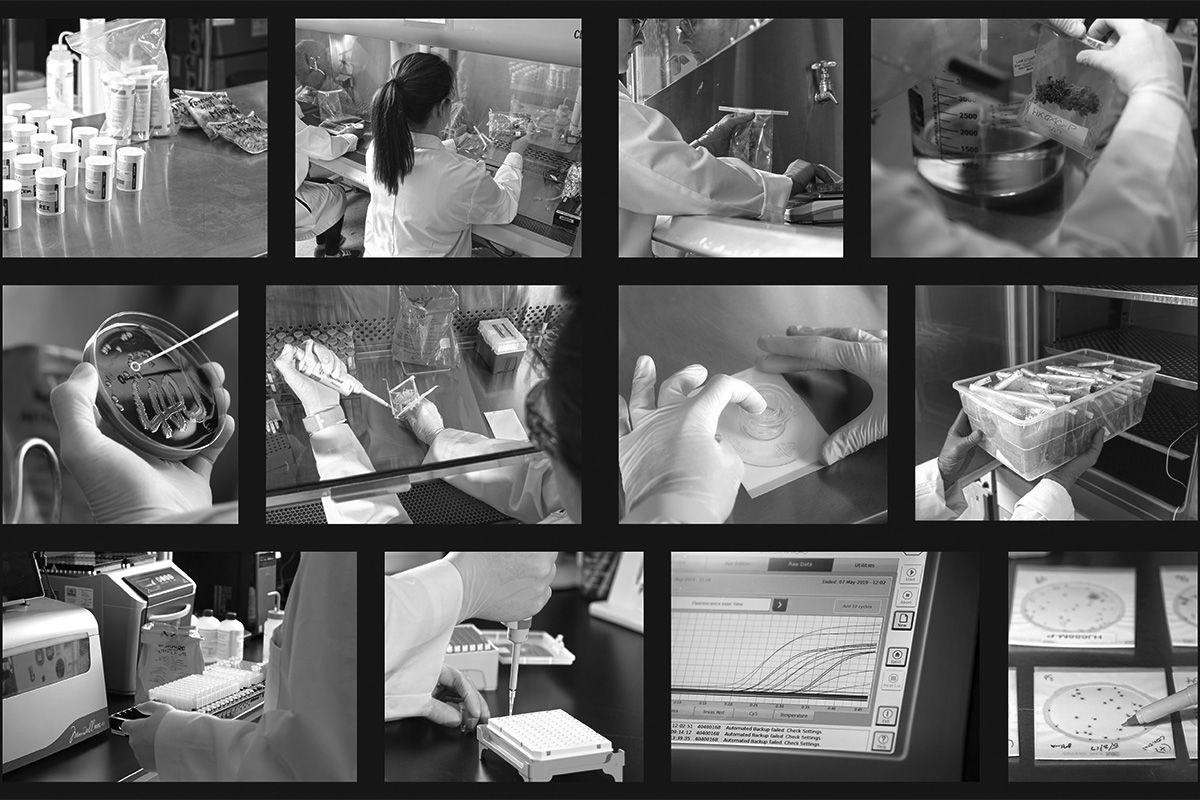Biocontaminants such as yeast, mold, E. coli and salmonella can be a costly problem for marijuana cultivators or cannabis-infused product manufacturers.
They can wreak havoc on a facility or cause product to fail mandatory tests, which can require large batches to be destroyed or remediated and sold at a discount on the wholesale market.
Operators often don’t detect these fungal and bacterial contaminants until it’s too late.
Monitoring the microbial loads of cannabis flower or infused products such as edibles and beverages is a critical part of the laboratory testing process
Rm3 Labs invited Marijuana Business Magazine to its facility to give operators a behind-the-scenes peek at some of the best practices for biocontaminant testing.

1. Prepare a Biosafety Cabinet
Rm3 Labs prepares a NuAire biosafety cabinet for biocontaminant testing. Biosafety cabinets provide a ventilated, clean and enclosed workspace equipped with High Efficiency Particulate Air (HEPA) filters that capture and trap microcontaminants and microparticles. This provides an aseptic or contaminant-free environment for laboratory analysts to split samples. For example, one product sample may be split for two or more tests—say biocontaminants and pesticides. Rm3 uses biosafety cabinets to minimize the risk of exposing samples to contaminants that might be present in the environment or other samples.

2. Split and Weigh Samples
Laboratory analysts split and weigh samples in the biosafety cabinet. The cabinet is designed to ensure the samples are not exposed to outside contaminants. Laboratory analysts split samples into Whirl-Pak bags. This is a common best practice because these bags are individually sealed and sterile.

3. Monitor the Environment
The agar plate in the bottom right corner of the photo contains compounds and nutrients that encourage fungal and bacterial growth. If fungal and bacterial contaminants are present in the cabinet, they’ll grow on the agar plate. This quality-control measure shows the lab and its clients that contaminants are not present in the cabinet during sample processing and demonstrates aseptic technique was used by the analysts. Aseptic technique is a set of strict, controlled practices used to prevent contamination during microbiology testing.
The laboratory also uses agar plates in the biosafety cabinets when no analysts are working there to ensure the HEPA filters are functioning properly.

4. Enrich Samples
After the samples are weighed and split into Whirl-Pak bags, they are enriched with a liquid broth medium. Nonspecific liquid mediums support the growth of a wide range of fungal and bacterial organisms. The amount of media that is added depends on the weight of the sample. If too much is added to a sample, it can dilute the contaminants; if too little is added, the contaminants can become concentrated and skew the lab results.
Laboratory analysts at Rm3 use a stationary dispenser to introduce the media so there is less chance of contamination. It can be adjusted to dispense the correct amount of liquid for each sample’s weight in a single pump.

5. Ready Quality-Control ‘Surrogates’
The laboratory analysts prepare quality-control samples with each batch of samples that are processed to help prove their processes are working each day of testing. Above, a laboratory analyst prepares quality-control samples, which, it’s important to note, are not client samples but “surrogate” samples that mimic client samples. This happens in a biosafety cabinet that is separate from where client samples are first split and weighed.
In this step, analysts inoculate control samples with live cultures to create “positive” samples while retaining uninoculated “negative” samples as well. Positive control samples contain cultures of fungal or bacterial contaminants—yeast, mold, E. coli or salmonella; negative control samples do not. These quality-control samples are important, and operators should ask to see the data produced from them if their product samples fail.
When tests are completed, positive control samples should test positive and negative tests should test negative if analysts have taken all the appropriate steps and used the correct instrument parameters throughout the process.

6. Dilute Samples
After the media is added and the sample is homogenized (i.e., mixed for uniformity), the sample is taken in the biosafety cabinet for Total Yeast and Mold (TYAM) plating. This is the first part of the biocontaminant test. An analyst uses a pipette to take an aliquot, or a portion, of the sample to dilute it with more media for yeast and mold testing.
The sample should be diluted before it is plated, because even after Step 4—the introduction of media to the sample—the sample could be too concentrated for analysts to count individual colonies of contaminants after plating. The dilution allows analysts to more accurately detect and calculate the contaminants.

7. Pipette Samples Onto Petrifilm and Store
The diluted sample aliquot is placed on TYAM 3M Petrifilm, which is a newer and more sustainable plating technology commonly used in the food and environmental testing industries. Once the sample aliquot is pipetted in the shallow reservoir of the Petrifilm, it forms a gel-like substance on the film, which contains nutrients that promote the growth of fungi and antibiotics that prevent the growth of bacteria. Pressure should be applied evenly to distribute the sample and fill the reservoir. Any sample media pressed outside the reservoir will not be included in the test analysis. After about 60 seconds, the gel solidifies and then is stored in a temperature-controlled incubator for 60-72 hours. That amount of time allows colony-forming units (CFU) of present contaminants to grow.

8. Incubate Undiluted Samples
Analysts aren’t yet done with Whirl-Pak bags containing the undiluted samples. They are needed for the second part of the biocontaminant test, which is for E. coli and salmonella. This part requires the samples to be stored in a separate incubator overnight. In most states with legalized cannabis, E. coli and salmonella must be less than 1 CFU per gram—in other words, absent in cannabis and cannabis-derived products. Overnight incubation gives the bacteria enough time to continually double its population until it is able to be detected by DNA-based testing methods.

9. Extract DNA from Samples
After the Whirl-Pak bags are stored overnight, they’re removed from the temperature-controlled incubator. A laboratory analyst takes a second portion of the sample, or aliquot, from the bag and prepares it for DNA extraction by a Promega Maxwell instrument. The Maxwell is an automated DNA-purification system that is capable of consistently and reliably extracting DNA from complex samples.
Some laboratories use a spin-column procedure or other manual processes for DNA extraction. Manual extraction is time-consuming and requires several steps. Laboratories can save time and money investing in technology such as the Maxwell Promega instrument, which can extract DNA from 48 samples in 35 minutes. Since the instrument automates the process, there’s also less risk of error, so the lab’s clients can rest assured their samples are being processed correctly. The DNA is extracted into an elution buffer that has a slightly basic pH to stabilize the DNA molecules and prevent their degradation.

10. Plate Samples for qPCR Analysis
This part of the process requires meticulous work and involves a quantitative polymerase chain reaction (qPCR) method. Rm3 Labs’ qPCR method uses a specific DNA sequence present in all species of shiga toxin-producing E. coli and salmonella that is attached to a fluorescent probe to detect if these bacteria are present in samples The target sequence is not shared by other bacteria or organisms.
After the DNA samples are extracted, an analyst pipettes the sample into a 96-well plate. Inside each well is the qPCR chemistry that allows for the detection of a target DNA sequence. qPCR reaction chemistries can be purchased in kits from manufacturers, but Rm3 Labs has developed its own. That cuts costs, which reduces the prices for some tests.
Remember those quality-control samples mentioned earlier? The DNA from those samples is also extracted and plated for qPCR analysis alongside client samples. If the “positive” quality-control samples produce a positive result during qPCR, this tells the lab that the correct procedures were used to extract DNA from all samples in the batch and assures the lab that client samples producing a negative result are truly negative, ruling out any false negatives. Other quality controls are added to the qPCR plate to ensure the qPCR reaction chemistries were prepared appropriately.

11. Load the qPCR Machine
The 96-well plate with samples is loaded into the qPCR machine. The plate is repeatedly heated and cooled over 45 minutes to amplify, or increase, the DNA in the sample. Heating the plate breaks apart the two strands of any DNA present in the samples, and cooling allows for newly assembled DNA strands to anneal—in other words, be brought back together. During this process, if the target DNA sequence of the bacteria of interest is present, the probe attached to the target DNA sequence will cause a fluorescent signal on the qPCR machine. As the DNA of interest is amplified, the probe’s fluorescence is also increased, and this is shown in an S-shaped, curved line. The sooner the curved line pops up on the screen, the more concentrated the DNA of the bacteria of interest is within the sample. In the tens of thousands of samples that Rm3 Labs has tested, the laboratory has detected salmonella in only one sample. The curved lines on the screen show the results for positive quality control samples. All other lines are flat, which is what an operator hopes to see in client samples because it indicates no bacteria of interest is present.

12. Count Colony-Forming Units
After 60-72 hours in a temperature-controlled incubator, the TYAM 3M Petrifilm plates are removed and the CFUs on each plate are counted. The Petrifilm contains an indicator dye that shows the presence of yeast and mold colony-forming units by coloring them blue, making it easier to count the number of colonies. The number of CFUs on the plate correlate to the level of fungal contamination in the product. Several states have an acceptable limit of 10,000 CFUs of yeast and mold per gram of product, and any result over that limit fails testing.
Operators can use the data from TYAM testing to monitor changes in their operation. For example, cultivators who introduce a pest-management system can compare the number of CFUs of yeast or mold before and after implementation. That can help them determine whether their new system is decreasing the biocontaminant levels in their products over time.





